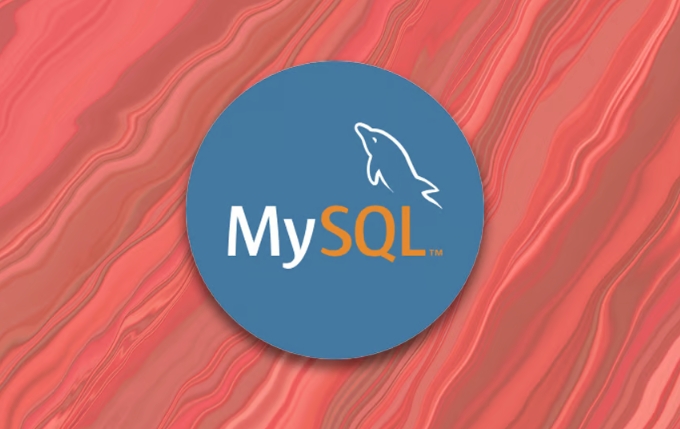Performing logical backups using mysqldump in MySQL
mysqldump is a common tool for performing logical backups of MySQL databases. It generates SQL files containing CREATE and INSERT statements to rebuild the database. 1. It does not back up the original files, but converts the database structure and content into portable SQL commands; 2. It is suitable for small databases or selective recovery, and is not suitable for fast recovery of TB-level data; 3. Common options include --single-transaction, --databases, --all-databases, --routines, etc.; 4. Use the mysql command to import during recovery, and foreign key checks can be turned off to improve speed; 5. It is recommended to test backup regularly, use compression, automated scheduling, naming with metadata and monitoring disk space.

When you need to back up your MySQL databases, mysqldump is one of the most commonly used tools for performing logical backups. It generates SQL files that contain CREATE and INSERT statements needed to rebuild the database. This method is especially useful when you want to migrate data, restore selectively, or version-control schema changes.

What a Logical Backup with mysqldump Actually Does
A logical backup isn't a direct copy of your database files on disk — instead, it's a set of SQL statements that can recreate your database structure and contents. When you run mysqldump , it reads the tables from your running MySQL server and converts them into text-based SQL commands.

This means:
- You're not backing up raw
.ibdor.frmfiles. - The output is portable across different platforms and MySQL versions (to some extent).
- It's not the fastest way to back up huge databases, but it's flexible and easy to inspect or modify.
So if you're looking for something quick for disaster recovery of terabyte-scale data, this might not be the best choice. But for smaller databases or selective restores, it's solid.

Basic Command Structure and Common Options
The basic usage of mysqldump looks like this:
mysqldump [options] [db_name [tbl_name ...]]
Here are a few practical examples based on real-world scenarios:
Dump a single database:
mysqldump -u username -p dbname > backup.sql
Dump multiple databases:
mysqldump -u username -p --databases db1 db2 > backup.sql
Dump all databases:
mysqldump -u username -p --all-databases > backup.sql
Some options you'll often see:
-
--single-transaction: Helps get a consistent snapshot without locking tables (good for InnoDB). -
-hor--host: Connects to a remote MySQL server. -
--routines,--events,--triggers: Include stored routines, events, and triggers in the dump. -
--no-dataor-d: Only dump the schema, not the data.
If you're planning to use these dumps for restoring later, consider adding --add-drop-table or --add-drop-database so that existing tables are dropped before being recreated.
How to Restore From a Dump File
Restoring from a mysqldump file is straightforward. You just feed the SQL file back into the mysql command-line client:
mysql -u username -p dbname < backup.sql
But here's what people sometimes forget:
- If the database doesn't exist already, create it first.
- Make sure the user has proper privileges.
- If the dump includes multiple databases or uses
CREATE DATABASE, you might not need to specify a target database name.
Also, large dumps can take time. If you're restoring a multi-gigabyte file, consider disabling foreign key checks at the start:
SET foreign_key_checks = 0;
Then re-enable them after import:
SET foreign_key_checks = 1;
Just be cautious — turning off constraints can lead to inconsistencies if the data isn't clean.
Tips for Managing mysqldump Backups Effectively
Backups only help if they work when you need them. Here are a few tips to make your workflow smoother:
Test your backups regularly : Try restoring them somewhere safe to ensure they haven't been corrupted or missed something important.
Use compression : Pipe the output to
gzipto save space:mysqldump -u user -p dbname | gzip > backup.sql.gz
Automate with cron : Schedule regular backups using cron jobs. Just remember to handle rotation — old backups take up space too.
Include metadata in filenames : Add date or version info to your backup files so it's easier to track which one is currently:
mysqldump -u user -p dbname > backup_$(date %F).sql
Monitor disk space : Especially if you keep daily backups, make sure your storage doesn't fill up unexpectedly.
You don't need anything fancy to start with mysqldump . Just a little planning and consistency go a long way.
Basically that's it.
The above is the detailed content of Performing logical backups using mysqldump in MySQL. For more information, please follow other related articles on the PHP Chinese website!

Hot AI Tools

Undress AI Tool
Undress images for free

Undresser.AI Undress
AI-powered app for creating realistic nude photos

AI Clothes Remover
Online AI tool for removing clothes from photos.

Clothoff.io
AI clothes remover

Video Face Swap
Swap faces in any video effortlessly with our completely free AI face swap tool!

Hot Article

Hot Tools

Notepad++7.3.1
Easy-to-use and free code editor

SublimeText3 Chinese version
Chinese version, very easy to use

Zend Studio 13.0.1
Powerful PHP integrated development environment

Dreamweaver CS6
Visual web development tools

SublimeText3 Mac version
God-level code editing software (SublimeText3)

Hot Topics
 Performing logical backups using mysqldump in MySQL
Jul 06, 2025 am 02:55 AM
Performing logical backups using mysqldump in MySQL
Jul 06, 2025 am 02:55 AM
mysqldump is a common tool for performing logical backups of MySQL databases. It generates SQL files containing CREATE and INSERT statements to rebuild the database. 1. It does not back up the original file, but converts the database structure and content into portable SQL commands; 2. It is suitable for small databases or selective recovery, and is not suitable for fast recovery of TB-level data; 3. Common options include --single-transaction, --databases, --all-databases, --routines, etc.; 4. Use mysql command to import during recovery, and can turn off foreign key checks to improve speed; 5. It is recommended to test backup regularly, use compression, and automatic adjustment.
 Setting up asynchronous primary-replica replication in MySQL
Jul 06, 2025 am 02:52 AM
Setting up asynchronous primary-replica replication in MySQL
Jul 06, 2025 am 02:52 AM
To set up asynchronous master-slave replication for MySQL, follow these steps: 1. Prepare the master server, enable binary logs and set a unique server-id, create a replication user and record the current log location; 2. Use mysqldump to back up the master library data and import it to the slave server; 3. Configure the server-id and relay-log of the slave server, use the CHANGEMASTER command to connect to the master library and start the replication thread; 4. Check for common problems, such as network, permissions, data consistency and self-increase conflicts, and monitor replication delays. Follow the steps above to ensure that the configuration is completed correctly.
 Implementing Transactions and Understanding ACID Properties in MySQL
Jul 08, 2025 am 02:50 AM
Implementing Transactions and Understanding ACID Properties in MySQL
Jul 08, 2025 am 02:50 AM
MySQL supports transaction processing, and uses the InnoDB storage engine to ensure data consistency and integrity. 1. Transactions are a set of SQL operations, either all succeed or all fail to roll back; 2. ACID attributes include atomicity, consistency, isolation and persistence; 3. The statements that manually control transactions are STARTTRANSACTION, COMMIT and ROLLBACK; 4. The four isolation levels include read not committed, read submitted, repeatable read and serialization; 5. Use transactions correctly to avoid long-term operation, turn off automatic commits, and reasonably handle locks and exceptions. Through these mechanisms, MySQL can achieve high reliability and concurrent control.
 Handling character sets and collations issues in MySQL
Jul 08, 2025 am 02:51 AM
Handling character sets and collations issues in MySQL
Jul 08, 2025 am 02:51 AM
Character set and sorting rules issues are common when cross-platform migration or multi-person development, resulting in garbled code or inconsistent query. There are three core solutions: First, check and unify the character set of database, table, and fields to utf8mb4, view through SHOWCREATEDATABASE/TABLE, and modify it with ALTER statement; second, specify the utf8mb4 character set when the client connects, and set it in connection parameters or execute SETNAMES; third, select the sorting rules reasonably, and recommend using utf8mb4_unicode_ci to ensure the accuracy of comparison and sorting, and specify or modify it through ALTER when building the library and table.
 Connecting to MySQL Database Using the Command Line Client
Jul 07, 2025 am 01:50 AM
Connecting to MySQL Database Using the Command Line Client
Jul 07, 2025 am 01:50 AM
The most direct way to connect to MySQL database is to use the command line client. First enter the mysql-u username -p and enter the password correctly to enter the interactive interface; if you connect to the remote database, you need to add the -h parameter to specify the host address. Secondly, you can directly switch to a specific database or execute SQL files when logging in, such as mysql-u username-p database name or mysql-u username-p database name
 Managing Character Sets and Collations in MySQL
Jul 07, 2025 am 01:41 AM
Managing Character Sets and Collations in MySQL
Jul 07, 2025 am 01:41 AM
The setting of character sets and collation rules in MySQL is crucial, affecting data storage, query efficiency and consistency. First, the character set determines the storable character range, such as utf8mb4 supports Chinese and emojis; the sorting rules control the character comparison method, such as utf8mb4_unicode_ci is case-sensitive, and utf8mb4_bin is binary comparison. Secondly, the character set can be set at multiple levels of server, database, table, and column. It is recommended to use utf8mb4 and utf8mb4_unicode_ci in a unified manner to avoid conflicts. Furthermore, the garbled code problem is often caused by inconsistent character sets of connections, storage or program terminals, and needs to be checked layer by layer and set uniformly. In addition, character sets should be specified when exporting and importing to prevent conversion errors
 Designing a Robust MySQL Database Backup Strategy
Jul 08, 2025 am 02:45 AM
Designing a Robust MySQL Database Backup Strategy
Jul 08, 2025 am 02:45 AM
To design a reliable MySQL backup solution, 1. First, clarify RTO and RPO indicators, and determine the backup frequency and method based on the acceptable downtime and data loss range of the business; 2. Adopt a hybrid backup strategy, combining logical backup (such as mysqldump), physical backup (such as PerconaXtraBackup) and binary log (binlog), to achieve rapid recovery and minimum data loss; 3. Test the recovery process regularly to ensure the effectiveness of the backup and be familiar with the recovery operations; 4. Pay attention to storage security, including off-site storage, encryption protection, version retention policy and backup task monitoring.
 Using Common Table Expressions (CTEs) in MySQL 8
Jul 12, 2025 am 02:23 AM
Using Common Table Expressions (CTEs) in MySQL 8
Jul 12, 2025 am 02:23 AM
CTEs are a feature introduced by MySQL8.0 to improve the readability and maintenance of complex queries. 1. CTE is a temporary result set, which is only valid in the current query, has a clear structure, and supports duplicate references; 2. Compared with subqueries, CTE is more readable, reusable and supports recursion; 3. Recursive CTE can process hierarchical data, such as organizational structure, which needs to include initial query and recursion parts; 4. Use suggestions include avoiding abuse, naming specifications, paying attention to performance and debugging methods.







